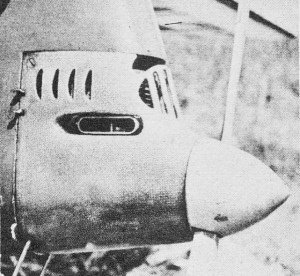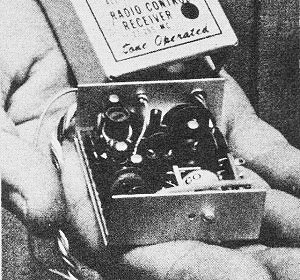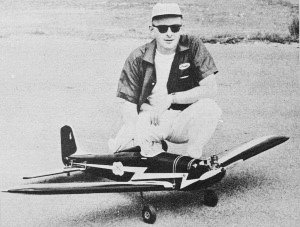|
It's hard to imagine a time when radio control
was such a novelty that contests included events where models were steered around
on the ground to weave through obstacles, as was the case when this 1957 American
Modeler magazine article was published. The thing is, when I got my first R/C
system, an OS Digital
3−channel set, I had not yet learned to fly so I "drove" my S−Ray around the
yard and in the street in front of my house. The noise from the OS .20 engine
and the RF interference on television VHF channel 5 annoyed the neighbors at
times. My transmitter was at 27.195 MHz, and the harmonics fell squarely into
the RF and audio bands. My best friend back in the day had one of the Smog Hogs
referred to in the article. In 1957, radio systems only approximated
proportional control, so smooth maneuvers were not easy to do. Receiver tuning
was necessary between flights for a lot of systems, and interference from other
users in or near the 27 MHz band was a constant threat to models. Flyers with
Ham licenses were able to operate on frequencies with more protection.
Western Modeling by Dick Everett
Radio Circus Real Laugh Riot
 Dean Kenney's No-it's-not-a-Smog-Hog (left)
sprays spectators with perfume at LARKS' radio control circus. Dean Kenney's No-it's-not-a-Smog-Hog (left)
sprays spectators with perfume at LARKS' radio control circus.
The Larks' R/C circuit was an outstanding success. The largest crowd to witness
a model meet in California this year was treated to a "show" that was better than
many others which they could have plunked down a five spot to see.
Activity was continuous with 28 possible radio control stunts listed for points
plus special trophies for the most novel stunts. Most points you could garner in
anyone stunt was for skywriting or for a carrier-arrester landing, neither of which
anyone managed. Some of the contestants attempted the "carrier" - all griped about
the small deck. It was, too; models looked like B-36's while on the deck!

The Calypso Kid (Dean Kenney) turned out in red & white costume, including
shoes! Note balloons on judge's hat.
Demerits
On the debit side, if one pulled a "Kenney Flounder"
(whatever that was) he lost 10 points and for soft-soaping (or "Bonnerizing") the
judges from 0 to minus 50. We didn't see any attempted inverted landings or inverted
takeoffs but they were worth 30 points if one made it.
Entrants tried everything from drop-the-hankie, bomb drops, parachute drops,
glider drops, combat, airmail to point delivery and return - just about everything
you could name.
The airmail point-to-point delivery and return saw a lot of activity and some
difficulties since the landing point was some 200 yards away. Landings that far
followed by a "taxi" to the person the mail was addressed to was a little tough.
Return flight to the judges was awaited eagerly since the questions and answers
were quite funny. Dean Kenney's answer to "What is your name?" of "Lover Boy" brought
loud laughs from everyone. "Win" Biscay's answer to the question "How old are you?"
("Guess") still has them thinking.
Close Race
Pylon racing found a lot of guys trying this for
the first time. Bob Dunham and Ray Downs flew a spectacular race. Ray led most of
the way and at times was as much as a half a lap ahead but Bob put on a spectacular
burst of speed coupled with some tight flying to gain all this back in the last
lap and nose Ray out by 2.5 tenths of a second. Their planes were less than ten
feet apart when they crossed the finish line.
Dunham tried this course a second time, managed to clip almost 25 seconds off
his first mark, turning the 5 laps at an average speed of 23.71 mph. This was the
same "Smog Hog" with which he won first at the Nats. Biscay and Bill Williams tried
the course with rudder-only but ran out of time before they could finish.

Ray Down navigates the obstacle course; markers were set a mere 10 feet apart.
This required some real good piloting and a very maneuverable entry.

Fiberglass cowl on Bob Hunter's huge Class C free flight; Styrofoam body. (See
October A.M.) Italian engine.

Small handful is Deltron's all-transistor receiver. Four x-istors are tone modulated
800 to 1000 cycles.

Fred Dunn with his low-wing Smog-Hog. Everett reports model very neatly constructed,
has perfect take-off and landing pattern, is smooth flyer.
Mad Le Mans
A "Le Mans" start had the most contestants. Models
were lined up with the pit crews 50 feet from the flyers and planes. After a couple
of false starts when some of the mechanics got a little too eager, they ran to their
models and started the engines. Engines had to stay running while they dashed back
to the starting line and picked up a spare prop. Then back to their R/C jobs, stop
the engines, change props, re-start engines, run back to the starting line.
This event was a real mad house; the false starts were only the beginning. Some
engines didn't start so easily, some stopped with the contestants half way back
to the starting line, some fellows even forgot to drill out their props, some had
the wrong wrenches! All in all, the spectators got a big laugh and the entrants
had more fun than ever before. Ray Downs was the Le Mans winner with Fred Dunn a
very close second.
Beautiful Hog
Concourse D'Elegance was won by Fred Dunn with
- now hold on to your hats - a low-wing Smog Hog. Fred had finished the ship the
morning of the contest, the receiver and transmitter being "Orbits" were checked
out by Dunham, the servos being Bonner's were "Bonnerized" by the ole man hisself.
First test flight found everyone anxiously crowded around watching. With Bonner
at the controls the LWSH made a super-smooth takeoff for maximum points and then
up in what was a beautiful flight. Bonner rolled the ship, looped it everything
but the one stunt Dean Kenney wanted - an outside loop. Landing was perfection.
Only trim adjustment made to the ship was a little down-trim in the elevator and
a bit of right thrust. Fred Dunn is one of those real neat builders who manages
to always have the slick models which everyone admires and his "Smog-under-Hog"
is no exception.
Fly Two at Once
Trophies for the most novel stunts in rudder-only
and "multi" had the gang trying everything. Bill Williams topped the rudder-only
group by flying two R/C jobs at one time. He tried 3 but couldn't quite keep the
3rd one airborne. Want to do something difficult, then try this - it gets a little
grim when one model is behind you and one in front.
In multi, Dean Kenney borrowed a page from the latest brush fire fighting technique
and sprayed the crowd with a perfumed water solution.
There was a futile attempt made to bar Bonner from flying unless he put on his
South African shorts - this didn't get far sorry to relate.
Other winners named after all the fun was over were "Pappy" Biscay in rudder-only,
Dean Kenney in multi. Most humorous flight costume worn by Bill Luss. You can bet
there will be more of these contests by the Larks. Since it goes over big why doesn't
your club try one?
Nelson's New Rigs
We had a quick peek at Vic Nelson's all transistorized
tone modulated receiver and his new transmitter. Both look real good. Compactness
of receiver has lead him to build a 32" semi-scale job for the new Cox engine. All-up
weight of the receiver and battery can be as low as 2.5 ounces; complete with relay
it measures 3/4 x 1 1/4 x 2 1/8" and with a regular 22 1/2 volt battery weighs 3
ounces (with a 1/2 size battery weight is further reduced). This package includes
the relay; case is rugged .025 aluminum. Etched circuit uses Philco A01 and A02
transistors, 4 in all; super regen, tone modulation is 800 to 1000 cycles; idles
at less than 1 ma; jumps to more than 4 ma on signal.
The transmitter is also a printed circuit using two tubes, modulated to match
the receiver and in a well arranged package. As with the earlier Deltron transmitter,
antenna is coil-loaded for peak output. Vic claims this circuit is stable thru 115
degrees. Price is $29.95 for the receiver, $24.95 for the transmitter.
Multi Shakes
Colby Evett is a monster from outer space as far
as we are concerned. He put the 5 channel transmitter for his "Big Moe" in our trusting
little hands recently while the ship was high in the air. Never having flown a multi
ship before you can well imagine the feeling we had with a real hot ship on our
hands. After some anxious moments and some wrong control we managed to take a deep
breath and enjoy ourselves. Now the only difficulty is - we have a lap R/C "Over-the-Rainbow"
plane almost finished, we have a 5 channel CG receiver which we had intended to
use for rudder, breaks and motor but - Evett should be banned from flying. Colby,
in spite of what you did to us, the model will be finished as started - so there!
International Qualifications
FAI: what difference does the
rule changes make? - we could not see much. Out of 16 entries at Los Angeles, 9
qualified with minimum times, the models climbed just about as high, glided just
about as good.
In gas there were only two new airplanes, most fellows being content to pile
on lead. Harry Gould added 12 ounces 3/16 incidence. Dick Sladek's 520 wing and
250 tail were leaded up to 35 ounces but it didn't seem to matter a great deal.
The equalizer was the hand launch. It takes a good hand launch glider arm to get
these models started. One difference is more damage to models when obstacles are
hit. Bob Wiehle sheared his wing in two on a water sprinkler and was out. Erv Rodensky
dethermalized on a tree stump and shattered his covering. That kinetic force is
much greater.
Twenty-four entered Wakefield and contrary to other events the 20% limit qualified
the last member. For the first time in history no TT'er qualified. Frank Newquist's
winning 839 seconds was very good time. Some tried to fly on only 8 strands of rubber
and had a 2 minute plus prop run - but no altitude.
Posted March 18, 2024
(updated from original post on 5/20/2012)
|


